Over a Hundred Roofs Repaired After Typhoon Danas
By Chiu Chuan Peinn (周傳斌)
Edited and translated by Wu Hsiao-ting (吳曉婷)
Photos by Huang Xiao-zhe (黃筱哲)
Over a Hundred Roofs Repaired After Typhoon Danas
By Chiu Chuan Peinn (周傳斌)
Edited and translated by Wu Hsiao-ting (吳曉婷)
Photos by Huang Xiao-zhe (黃筱哲)
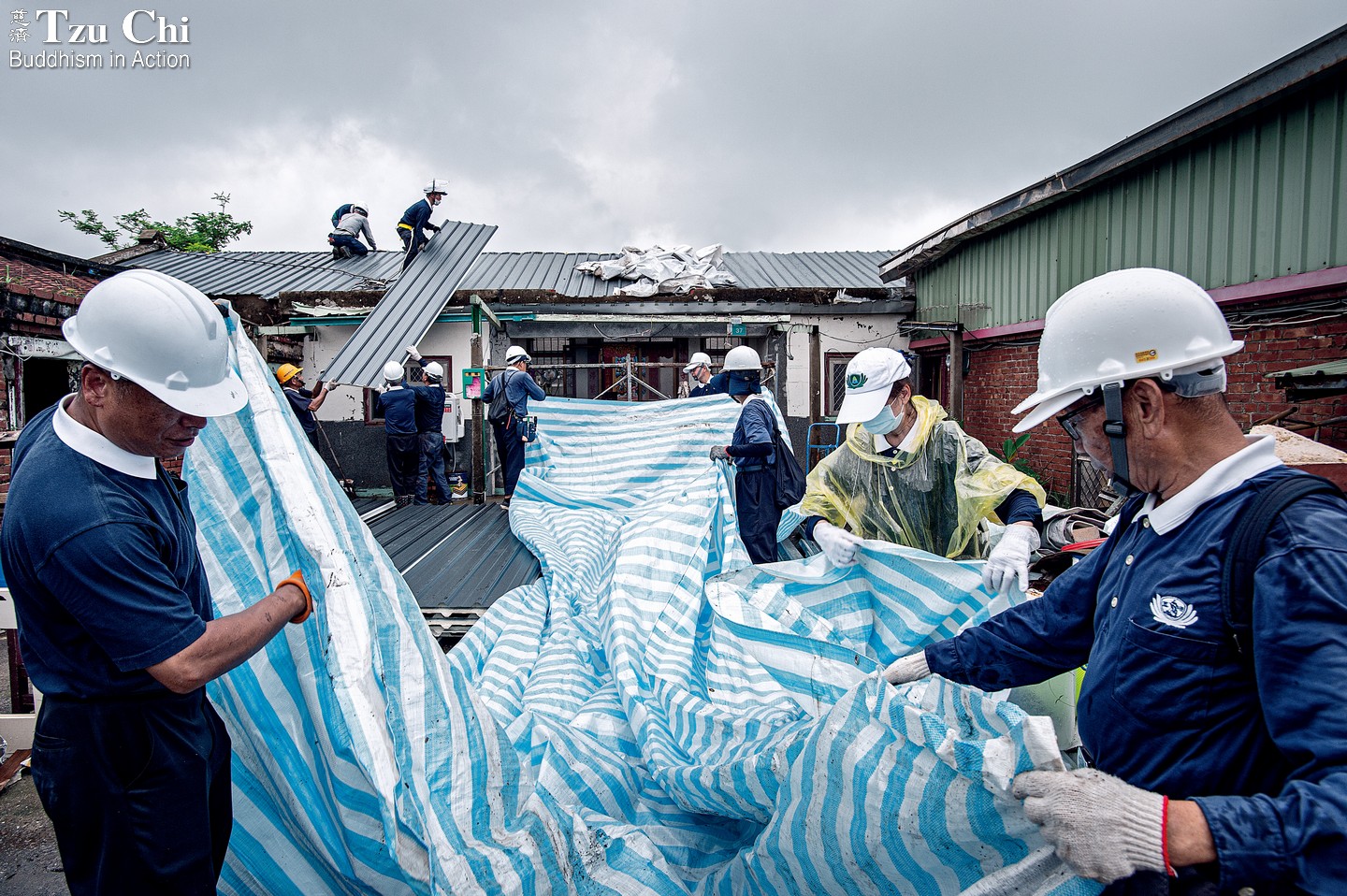
After Typhoon Danas struck Taiwan, Tzu Chi helped restore over a hundred roofs. Racing against time and making the most of every spell of good weather, repair teams brought smiles to disadvantaged residents—a reminder that after the rain, the sky always clears.
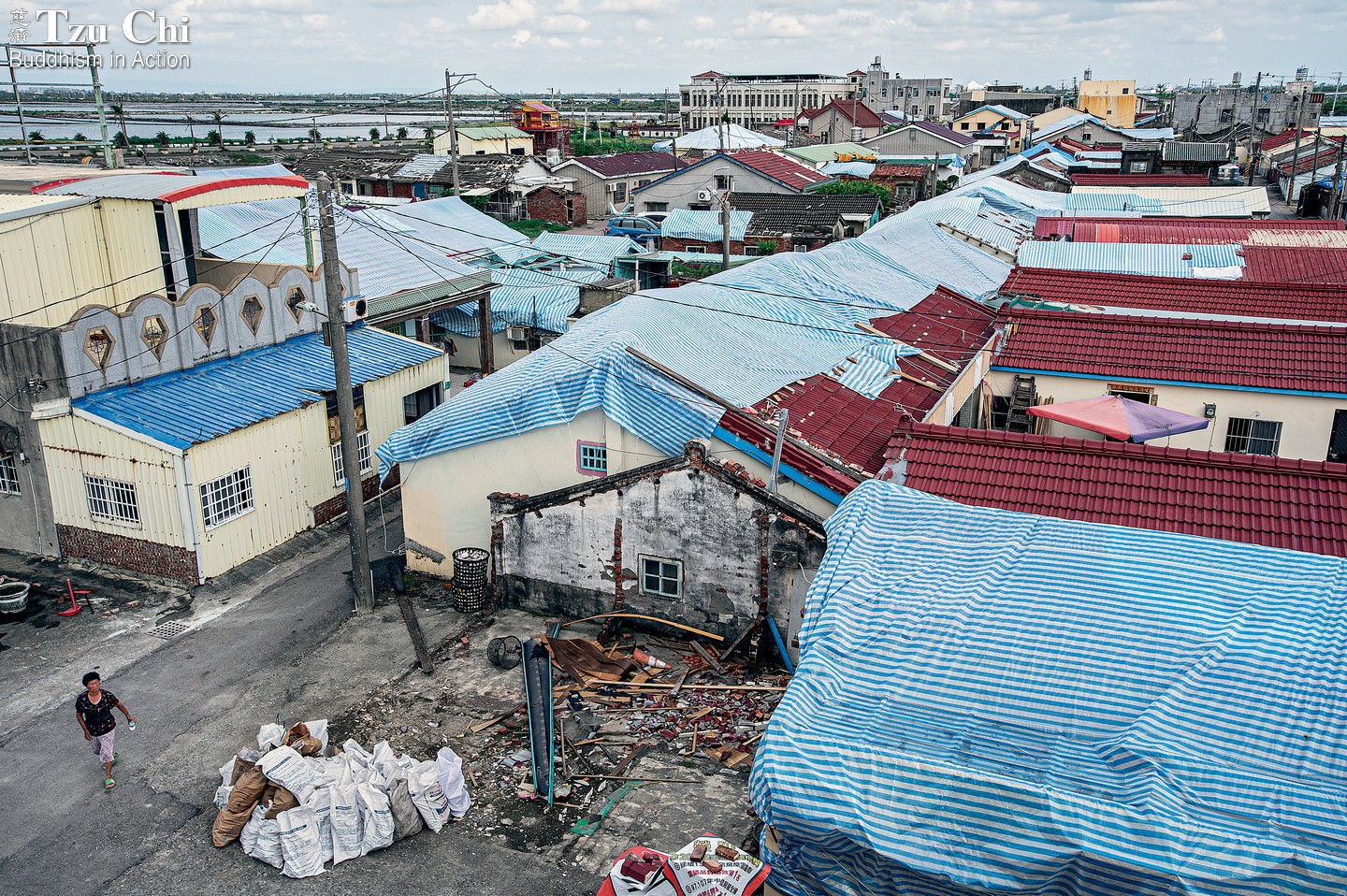
When It Rains, It Pours
Blue-and-white striped tarps, like giant bandages, temporarily cover roofs damaged by Typhoon Danas in Xiliao, along the coast of Qigu District, Tainan. Debris from homes, collected in white nylon bags, is set aside on open ground. Tzu Chi volunteers arrived in Xiliao just two days after the typhoon to provide initial support, followed by emergency cash and tarps. After three weeks of intermittent wind and rain, the second phase of relief began, with professional contractors enlisted to repair the roofs of vulnerable households.
Insulated corrugated panels and other roofing materials were stacked in front of a temple in Dingshan, Qigu District, Tainan City. On August 5, 2025, teams of three lifted C-channels—each four to five feet long—from the stacks onto their shoulders and carried them into narrow lanes.
Suddenly, the sky opened. Scattered raindrops gave way to a heavy downpour, shrouding the scene in a white haze. The volunteers from Kaohsiung hadn't had time to put on raincoats, and soon their clothes—down even to their socks—were soaked. They ducked under a resident's canopy, as the rain was too intense to continue working. The homeowner didn't seem to mind, and they exchanged smiles and a simple greeting.
Surprisingly, no one spoke of the sudden storm that had driven them to seek shelter. It was as if everyone was accustomed to such moments—like fishermen at sea who take the waves as they come.
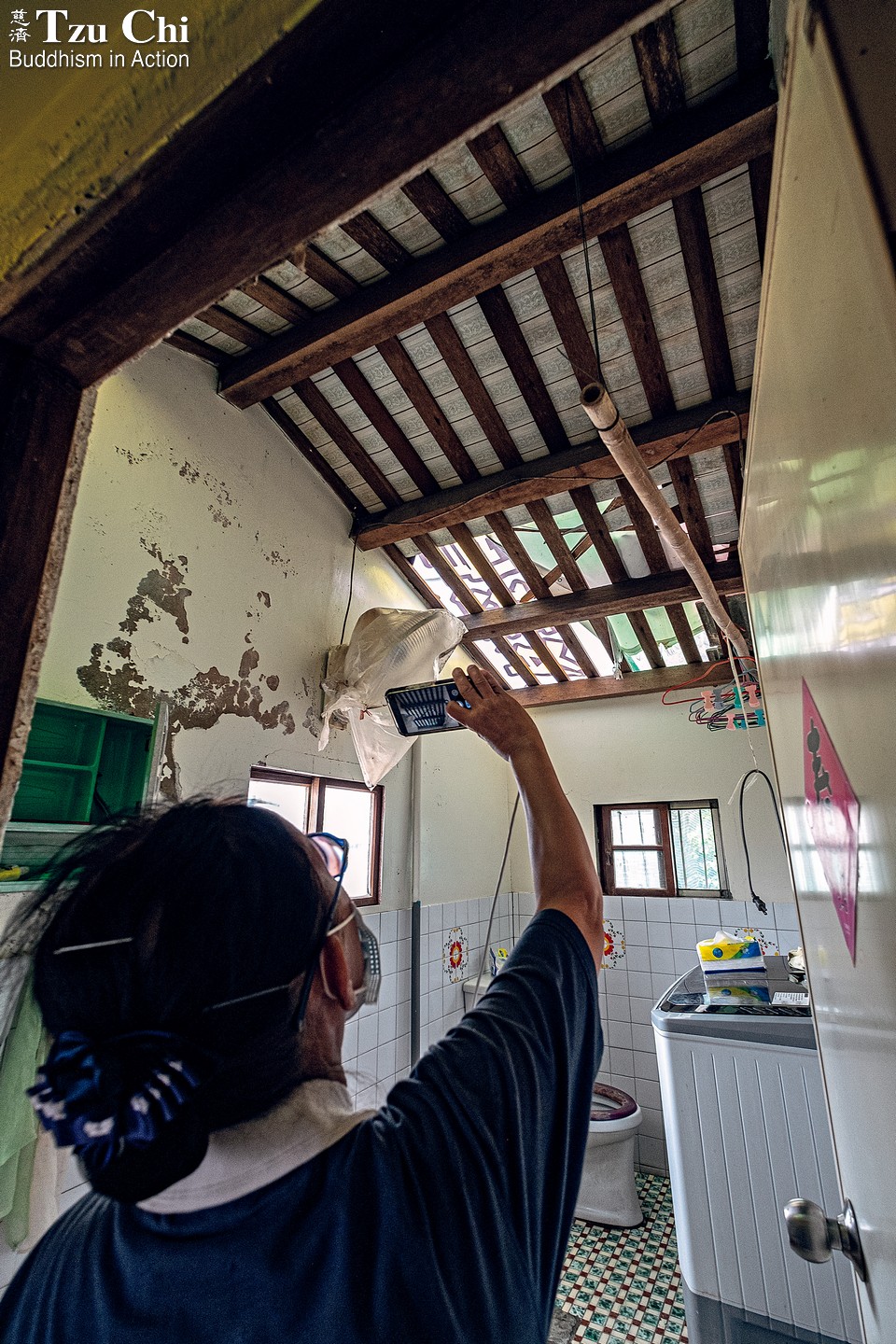
A volunteer documents damage and assesses repair needs for a household in Xiliao.
Contractors joining volunteers
Just a week before, a group of people had gathered early one morning at the Fishermen's Activity Center in Xiliao, also located in Qigu District. Most were Tzu Chi volunteers from Kaohsiung. The center, serving as a temporary service hub, buzzed with activity as the team prepared to repair the roofs of three old homes damaged by Typhoon Danas, which had devastated Tainan City and Chiayi County in early July.
Volunteers had begun arriving at the activity center by 8 a.m. Some prepared breakfast and invited everyone to eat, while others handled the day's tasks. After everyone had gathered, Pan Ji-li (潘機利), coordinator of the Tzu Chi Kaohsiung Disaster Response Center, and Wu Zong-hua (吳宗樺), deputy coordinator, thanked the team for coming. Pan reminded them: "Please don't take risks. There is a site supervisor, and we respect the supervisor's authority. Volunteers mustn't climb onto the roofs."
The volunteers then formed two neat lines and walked to one of the homes scheduled for repairs. Two skilled workers from Yuanxing Engineering were already on the roof, with a one-story-high scaffold set up beside it. Once the volunteers arrived, work to remove the remaining roof tiles began. The workers carefully passed intact tiles down to volunteers on the ground, who carried them to the homeowner's storage room.
Pan explained that volunteers had reached out through their personal networks to bring in professional contractors so they could tackle the repairs together. With damaged roofs causing serious inconvenience for residents, speed was essential—often, several houses had to be worked on at the same time.
Unfortunately, the weather was rarely on their side. The outer circulations of Typhoon Co-may and Tropical Storm Francisco had strengthened southwesterly airflows, bringing frequent rainstorms to southern Taiwan. Such heavy rain made it unsafe to work with electricity or on rooftops. Even so, whenever the rain eased or stopped, volunteers rushed to resume repairs.
As the work continued, the number of households willing to accept Tzu Chi's help steadily grew. Moved by the foundation's sincerity and reassured by the use of quality roofing materials, more residents signed up. The number of homes in Xiliao quickly expanded from single digits to more than 30.
"We are responsible for two neighborhoods in Qigu District: Xiliao and Dingshan," said Pan. The Kaohsiung team, with extensive experience in repair work, took on the more severely affected areas while coordinating both frontline labor and administrative tasks.
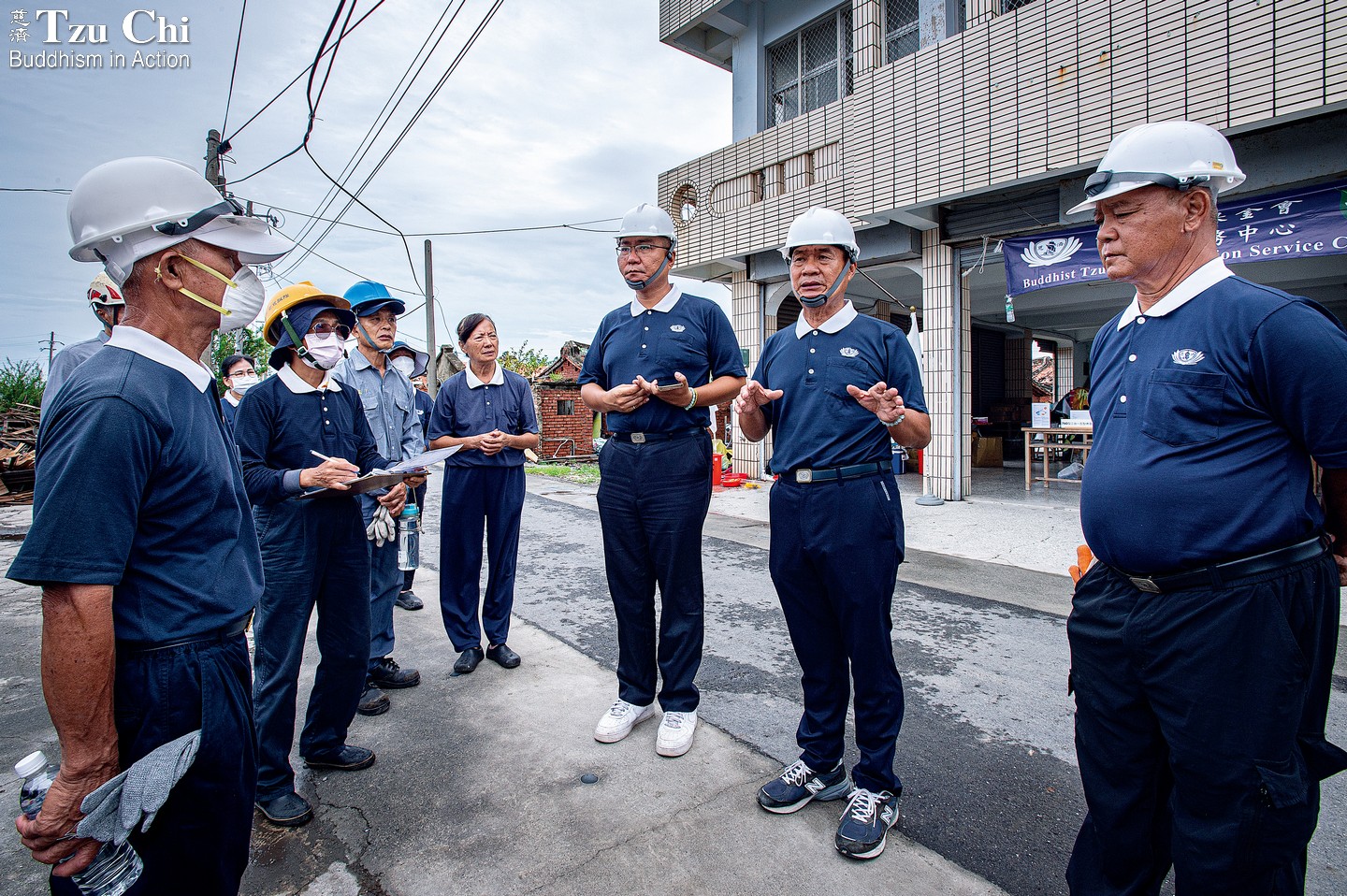
Pan Ji-li (second from right) and Wu Zong-hua (third from right) of the Kaohsiung team brief fellow volunteers on the day's tasks and safety precautions before beginning roof repairs in Xiliao.
Teamwork and shared responsibility
After Typhoon Danas, demand for roof repairs surged across Tainan. With local contractors in short supply, reinforcements arrived from other areas. In addition to the experienced Kaohsiung team, volunteers from Pingtung stepped forward, handling repairs for nine homes in Longshan, Qigu.
The Pingtung volunteers, following the Kaohsiung model, reached out to local contractors in their own county and invited them to join the effort. The coordinator and deputy coordinator of the Tzu Chi Pingtung Disaster Response Center were always present during site inspections and repair work, supported by administrative, logistics, and documentation teams. Notably, the Pingtung group also included social workers from the local Tzu Chi office. Social worker Zhang Zhi-xiang (張智翔) said that the Pingtung team was still in the early stages of providing this kind of repair assistance, and was eager to gain experience.
Huang Li-xiang (黃麗香), coordinator of the Tzu Chi Pingtung Disaster Response Center, shared that Master Cheng Yen had encouraged volunteers and social workers to see this large-scale disaster relief mission as an opportunity for growth. "Earlier this year, after the Dapu earthquake in Chiayi, Tzu Chi helped repair homes in Nanxi, Tainan, which was badly affected," Huang said. "Brother Zheng Qiu-cheng (鄭秋成) from our Pingtung area formed a team and joined that effort. But this time, being solely responsible for one neighborhood, we first needed to confirm everyone's willingness to take part." With a broad smile, she added, "In the end, everyone was more than willing to participate."
While volunteers and contractors from Kaohsiung and Pingtung traveled from their regions to help their "adopted" areas, local Tainan volunteers shouldered responsibility for districts such as Beimen and Xuejia. All of the affected areas—whether managed by Tainan teams or supported by Kaohsiung and Pingtung—required a range of logistical support. "Each day, about 40 to 50 Tainan volunteers are spread across the different districts, providing assistance for the frontline teams," said Lin Qian-yong (林千用), deputy coordinator of the Tzu Chi Tainan Disaster Response Center. Their work covered administration and documentation as well as daily logistics. Veteran volunteer Huang Hui (黃惠), also from Tainan, added, "For each team coming from outside Tainan, we arrange a dedicated administrative contact."
One essential task was preparing and delivering meals and snacks to repair teams at various sites. This work was divided among the Tzu Chi offices in Jiali, Rende, and Anping. Sudden downpours sometimes forced last-minute cancellations, and unexpected requests required rapid responses, but the volunteers adapted with ease.
"For example, just last night we learned we needed to prepare 350 servings of snacks today," explained Lin Su-xiang (林素香) from the Jiali office. She wasn't worried, though, about the large request. With a smile, she remarked that on occasions like this, volunteers always seemed to emerge like bodhisattvas from the ground, so shortages of workers were rarely a problem.
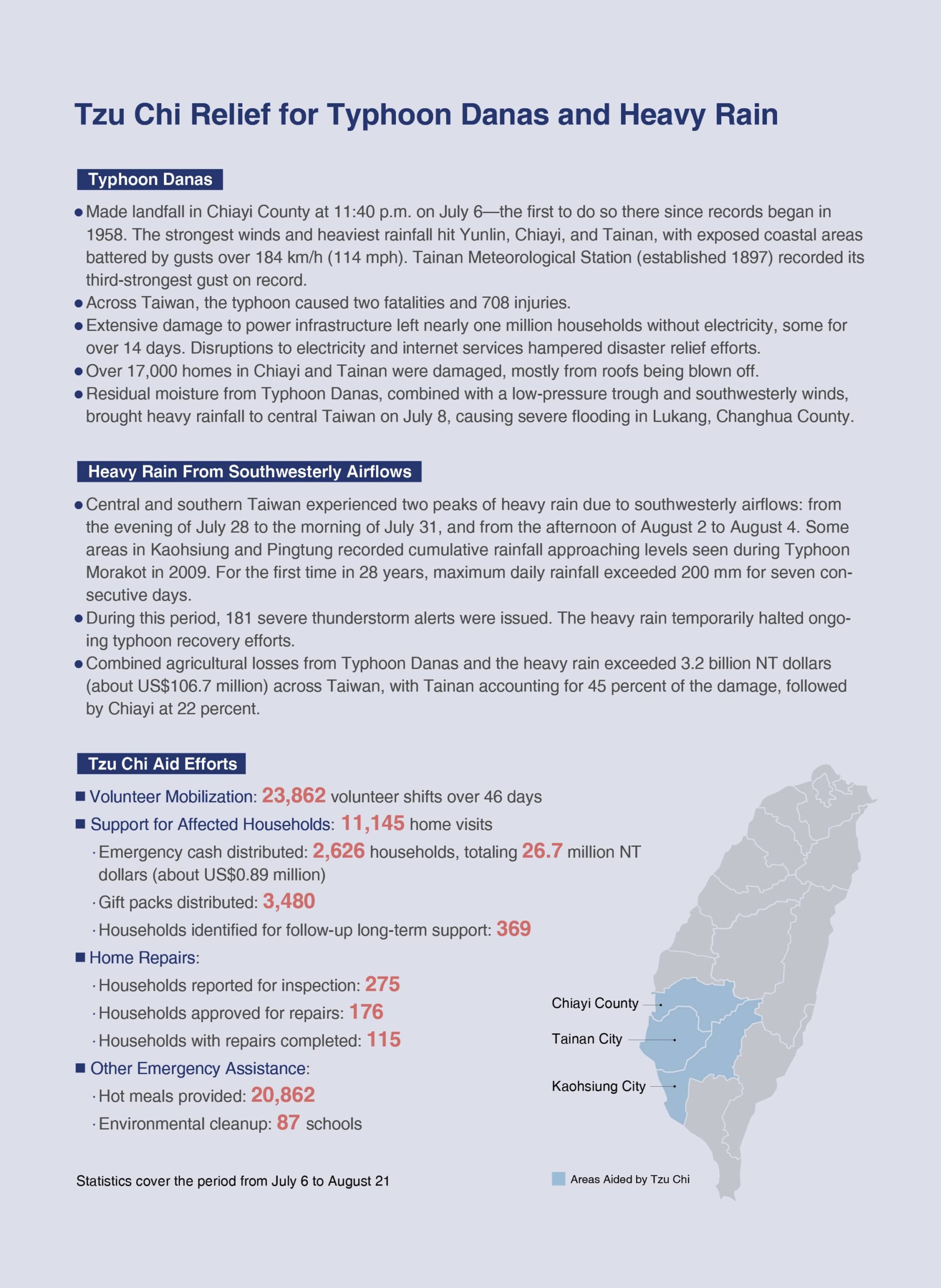
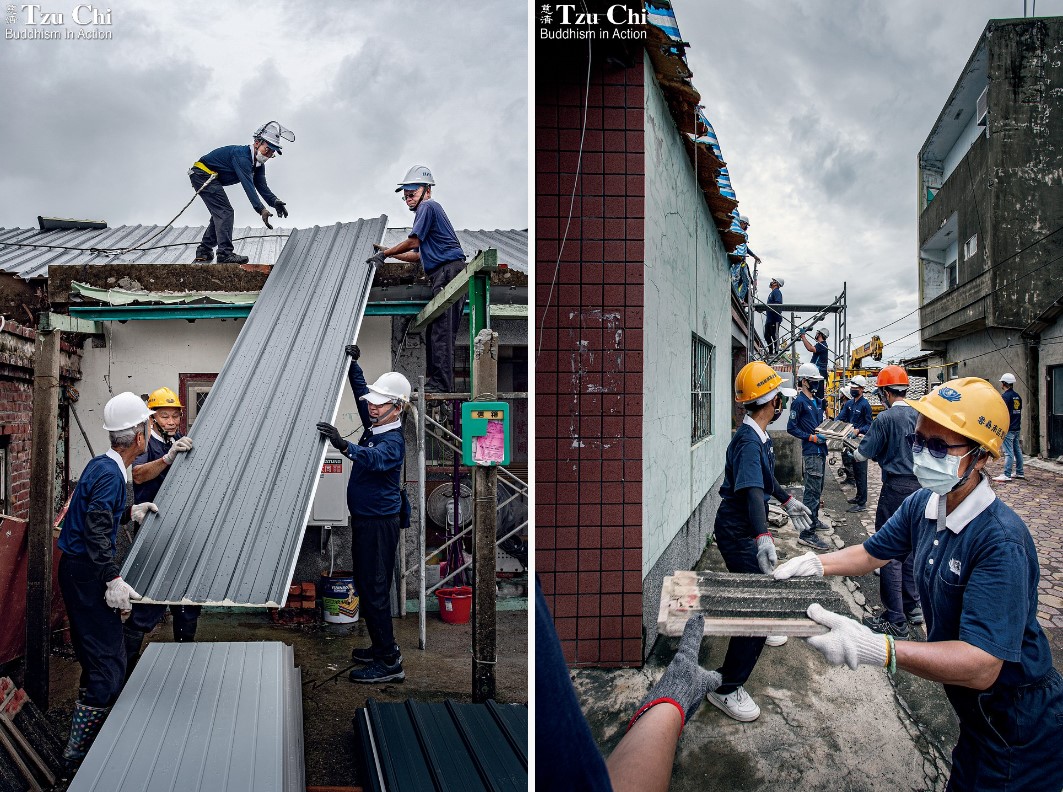
Work above two meters (6.6 feet) is handled by professional crews using certified safety equipment, while Tzu Chi volunteers assist by moving building materials and clearing the ground.
Cross-sector cooperation
On August 2 and 3, downpours driven by strong southwesterly airflows were so heavy that work and classes in Tainan had to be suspended. By August 4, although the weather was still far from ideal, Tzu Chi repair teams returned to disaster areas one after another, determined not to let progress stall. At noon that day, a sudden cloudburst hit Longshan in Qigu District, sending everyone hurrying for shelter at the local activity center.
At 1:30 p.m., Sun Qing-rong (孫清榮), who has an engineering background, noticed the rain easing. Rising to his feet, the burly volunteer called out, "The rain's letting up. Let's get moving!" His grandson and grandnephew immediately followed his lead.
Volunteer Lin Qi-ming (林啟明) explained the strategy the teams had adopted for unpredictable weather: When conditions allowed, they would pull back tarps covering a damaged roof and remove the underlying tiles. As soon as the rain returned, the tarps were quickly repositioned and work halted. Though cumbersome, this stop-and-go method prevented water from leaking into homes and damaging furniture.
Among the Tzu Chi volunteers who joined the foundation's repair effort after the typhoon was a unique group composed entirely of those with engineering experience: the Abode Maintenance Crew. Usually responsible for maintaining the Jing Si Abode, the Buddhist convent founded by Master Cheng Yen, they had traveled to southern Taiwan to lend their skills to disaster relief.
Unlike the Kaohsiung and Pingtung volunteers, who commuted at least an hour each way daily, the Abode Maintenance Crew, whose members came from across Taiwan, lodged at Tzu Chi's Jiali office. Early on the morning of August 5, more than 30 members rose in succession and prepared to have breakfast. Around seven o'clock, volunteer Chen Chong-guang (陳重光) looked up at the sky and said cheerfully, "Finally, we see the long-missed sun." Though the sky remained hazy, the forecast promised only a 30 percent chance of rain. Spirits lifted immediately. After breakfast and a brief prayer, the volunteers grabbed their safety helmets, boarded their vehicles, and within minutes, the convoy was on its way—ready for a new day of work.
In this repair effort, Tzu Chi partnered with the Tainan City Government to restore the roofs of disadvantaged households in five disaster-prone areas. Similar collaborations with public agencies were carried out in Chiayi County. Tzu Chi's construction department coordinated volunteers and professional contractors; selected durable, weather-resistant materials; and helped plan construction methods—all with the goal of enabling affected families to return to normal life as soon as possible.
In total, 18 professional contractors were brought into the repair effort, most from outside the affected area. Many temporarily set aside their own projects to support typhoon-stricken households. They came forward without hesitation, prioritizing the needs of families in recovery over their own schedules and costs.
Lin Bao-lu (林保爐), a contractor from Kaohsiung, recalled arriving in Xiliao and seeing half the village's rooftops covered with tarps. "It was really severe," he said. "I put the projects I had been working on on hold and came here with my son and employees. Even though this isn't our home, we couldn't just stand by." He added that he was impressed by the steel roofing panels Tzu Chi was using—they were thicker and of better quality than what's usually available. "For our part, we'll do as much as we can and finish the repairs as quickly as possible," he affirmed.
The damage to residential homes was both widespread and severe, creating an urgent need for skilled workers. Tzu Chi volunteers and contractors from different counties and cities converged into a coordinated force, forming an alliance of collective goodwill dedicated to helping communities rebuild.
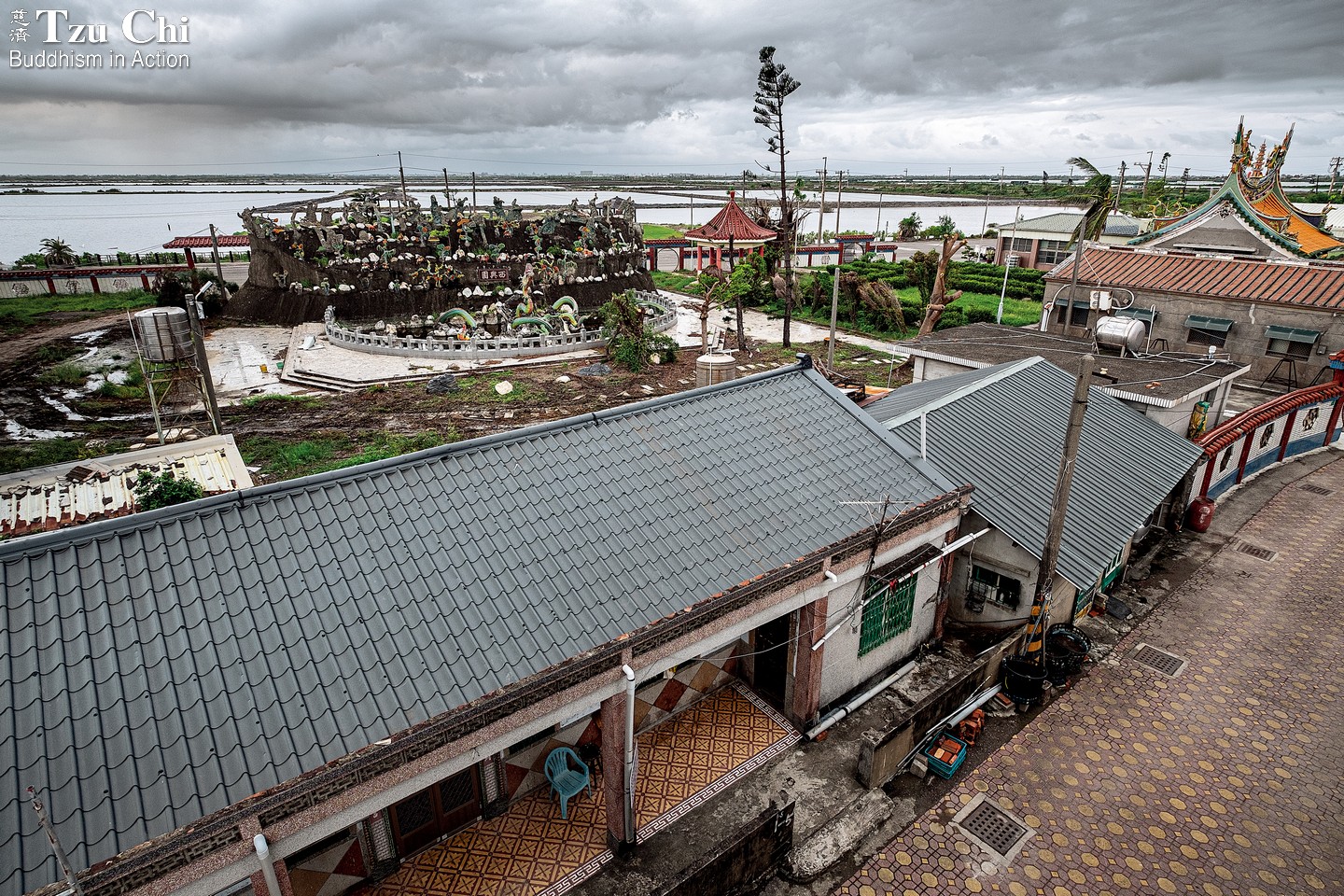
After Typhoon Danas, disaster areas faced shortages of building materials. Contractors handling repairs went to great lengths to secure what was needed. Although styles and material types varied, priority was given to materials that offered heat resistance, corrosion protection, and rapid construction.

Volunteers smile for the camera after completing repairs on a house in Dingshan, Qigu District, on August 3.
Contact Us | Plan a Visit | Donate
8 Lide Road, Beitou 11259, Taipei, Taiwan
886-2-2898-9999
[email protected]
©Tzu Chi Culture and Communication Foundation
All rights reserved.
